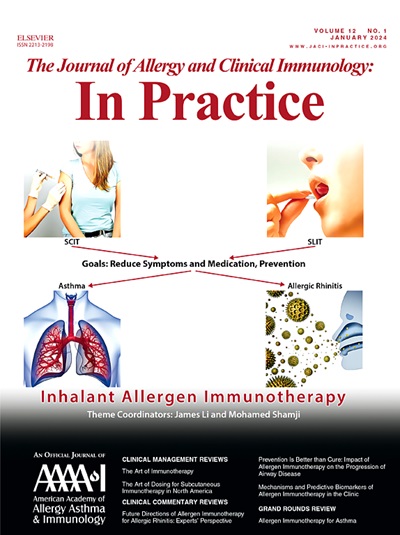Adverse Impacts of Corticosteroid Treatment on Osteoporosis/Osteopenia in Adult Asthmatics: A Retrospective ICARUS Cohort Study
IF 8.2
1区 医学
Q1 ALLERGY
Journal of Allergy and Clinical Immunology-In Practice
Pub Date : 2025-02-01
DOI:10.1016/j.jaip.2024.10.016
引用次数: 0
Abstract
Background
Inhaled corticosteroid (ICS) and oral corticosteroid (OCS) are often used in asthma management.
Objective
To evaluate the long-term effect of ICS/OCS on osteoporosis, osteopenia, fractures, and bone metabolism in adult patients with asthma in real-world clinical practice.
Methods
This is a retrospective study investigating deidentified electronic health records from Ajou University Medical Center (Korea). Adult patients with asthma receiving maintenance ICS with/without OCS for at least 1 year were enrolled. They were classified into the high/low-dose of ICS or OCS group. Primary outcomes (incidences of osteoporosis, osteopenia, and fractures) and secondary outcomes (drug prescription and laboratory values related to bone metabolism including albumin and alkaline phosphatase) were compared after 5 years of follow-up.
Results
After propensity score matching, both high- and low-dose OCS groups included 468 patients, and high/low-dose ICS groups each comprised 1252 patients. The risk of osteoporosis/major fracture was higher (hazard ratio [95% CI], 2.00 [1.15-3.57]/3.03 [1.04-11.11]) in the high-dose OCS group (especially in females aged ≥50 years) than in the low-dose group, although the ICS groups showed no significant differences. The high-dose ICS group showed a higher risk of osteopenia (1.92 [1.05-3.70]) than the low-dose ICS group. The linear mixed model of laboratory values showed significantly decreased serum albumin and increased alkaline phosphatase in the high-dose OCS group than in the low-dose OCS group.
Conclusions
The results of this study suggest that long-term use of OCS can increase the risk of osteoporosis and osteoporosis-related fractures, whereas long-term use of ICS may increase the risk of osteopenia in adult patients with asthma.
皮质类固醇治疗对成年哮喘患者骨质疏松症/骨质疏松的不利影响:一项回顾性 ICARUS 队列研究。
背景和目的:吸入皮质类固醇(ICS)和口服皮质类固醇(OCS)经常用于哮喘治疗。本研究评估了在实际临床实践中,ICS/OCS 对成年哮喘患者骨质疏松症、骨量减少、骨折和骨代谢的长期影响:这是一项回顾性研究,调查了韩国 Ajou 大学医疗中心的去标识化电子健康记录。研究对象为接受 ICS 维持治疗一年以上(含/不含 OCS)的成年哮喘患者。他们被分为高/低剂量 ICS 或 OCS 组。随访 5 年后,对主要结果(骨质疏松症、骨质疏松和骨折的发生率)和次要结果(药物处方和与骨代谢相关的实验室值,包括白蛋白和碱性磷酸酶 [ALP])进行了比较:经过倾向评分匹配后,高剂量和低剂量 OCS 组均包括 468 名患者,高剂量/低剂量 ICS 组各包括 1,252 名患者。高剂量 OCS 组(尤其是年龄≥50 岁的女性)发生骨质疏松症/重大骨折的风险高于低剂量组(危险比 [95% CI]; 2.00 [1.15-3.57]/3.03 [1.04-11.11]),但 ICS 组之间无显著差异。高剂量 ICS 组发生骨质疏松的风险(1.92 [1.05-3.70])高于低剂量 ICS 组。实验室值的线性混合模型显示,高剂量 OCS 组的血清白蛋白显著低于低剂量 OCS 组,ALP 则显著高于低剂量 OCS 组:本研究结果表明,长期使用 OCS 会增加骨质疏松症和骨质疏松症相关骨折的风险,而长期使用 ICS 可能会增加成年哮喘患者骨质疏松症的风险。
本文章由计算机程序翻译,如有差异,请以英文原文为准。
求助全文
约1分钟内获得全文
求助全文
来源期刊

Journal of Allergy and Clinical Immunology-In Practice
ALLERGYIMMUNOLOGY-IMMUNOLOGY
CiteScore
11.10
自引率
9.60%
发文量
683
审稿时长
50 days
期刊介绍:
JACI: In Practice is an official publication of the American Academy of Allergy, Asthma & Immunology (AAAAI). It is a companion title to The Journal of Allergy and Clinical Immunology, and it aims to provide timely clinical papers, case reports, and management recommendations to clinical allergists and other physicians dealing with allergic and immunologic diseases in their practice. The mission of JACI: In Practice is to offer valid and impactful information that supports evidence-based clinical decisions in the diagnosis and management of asthma, allergies, immunologic conditions, and related diseases.
This journal publishes articles on various conditions treated by allergist-immunologists, including food allergy, respiratory disorders (such as asthma, rhinitis, nasal polyps, sinusitis, cough, ABPA, and hypersensitivity pneumonitis), drug allergy, insect sting allergy, anaphylaxis, dermatologic disorders (such as atopic dermatitis, contact dermatitis, urticaria, angioedema, and HAE), immunodeficiency, autoinflammatory syndromes, eosinophilic disorders, and mast cell disorders.
The focus of the journal is on providing cutting-edge clinical information that practitioners can use in their everyday practice or to acquire new knowledge and skills for the benefit of their patients. However, mechanistic or translational studies without immediate or near future clinical relevance, as well as animal studies, are not within the scope of the journal.
 求助内容:
求助内容: 应助结果提醒方式:
应助结果提醒方式:


